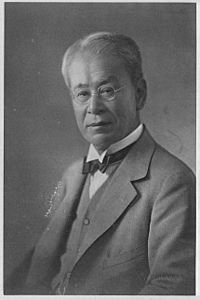Mentha japonica facts for kids
Quick facts for kids Mentha japonica |
|
|---|---|
| Conservation status | |
|
NT (Threatened Wildlife of Japan Red Data Book)
|
|
| Scientific classification | |
| Genus: |
Mentha
|
| Species: |
japonica
|
| Synonyms | |
|
|
Mentha japonica is a special type of mint plant. It grows only in Japan, specifically on the islands of Hokkaido and Honshu. A famous Japanese botanist named Tomitaro Makino first gave it its current name in 1906.
This plant is quite rare. The Japanese Ministry of Environment lists it as a "Near Threatened" species. This means it could become endangered if we don't protect its natural homes.
Contents
What's in a Name?
The scientific name Mentha japonica tells us where the plant comes from: "japonica" means "from Japan."
In Japanese, this plant has a few common names. One is Hime-megusa, and another is Hime-hakka (姫薄荷). Hime-hakka means "princess mint." People call it this because it's smaller than many other types of mint plants.
In Japan, there's a special way to give meanings to flowers, called hanakotoba. Mentha japonica represents "virtue" or goodness.
How Scientists Classify This Mint
Scientists generally agree that Mentha japonica is its own unique species. However, figuring out its exact family tree has been tricky. This is because mint plants often "hybridize," meaning they easily mix their genes with other mints. This creates new types of plants that share traits from two different parents.
Because of this mixing, scientists have had different ideas about which group Mentha japonica belongs to within the larger Mentha (mint) family. Some thought it was similar to Mentha arvensis, while others linked it to Mentha australis. More recently, in 2018, new studies suggested it's closely related to Mentha gattefossei. This shows how scientists keep learning more about plants!
Like most mints, Mentha japonica has a special chemical called menthol. This is what gives many mints their cool, fresh smell.
Scientists also study the plant's chromosomes, which are like tiny instruction books inside every cell. Mentha japonica usually has 48 chromosomes.
It can also create new hybrid plants in a lab when mixed with other mints like M. canadensis and M. aquatica.
What Does Mentha japonica Look Like?
Mentha japonica is a plant that lives for many years. It usually grows to be about 20 to 40 centimeters (about 8 to 16 inches) tall.
This mint spreads using thin underground stems called rhizomes. Its leaves are shaped like long ovals and have smooth edges. The flowers can be white or a light purple color. When you smell it, it reminds you of another mint called pennyroyal.
The plant also contains special oils called essential oils. These oils give the plant its unique smell and flavor. Scientists have found that the main chemicals in Mentha japonica's essential oil are menthone, isomenthone, and pulegone. The amounts of these chemicals can change depending on where the plant grows. For example, plants in Hokkaido might have more pulegone than those grown in Fukushima.
There's even a special type of Mentha japonica called form. prostrata. This one has a very long stem, sometimes over a meter (more than 3 feet) long, and it tends to lie down on the ground.
Where Does This Mint Grow?
Mentha japonica is found only in its natural home on the Japanese islands of Hokkaido and Honshu. It likes to grow in wet areas, like lowlands and mountain wetlands. It usually blooms, or flowers, from August to October in Japan.
As mentioned, this plant is rare. The Japanese Ministry of Environment has changed its status from "Vulnerable" to "Near Threatened." Sadly, it is now completely gone from Aichi Prefecture in Japan. This happened because its natural habitat was lost.
How People Use Mentha japonica
Like many other mints, Mentha japonica is used in different ways. People use it as an aromatic herb, which means it smells nice and can be used in cooking or for its scent.
It's also used in traditional remedies, which are old ways of treating illnesses. For example, ointments made with M. japonica have been used to help treat cows with a condition called mastitis.


